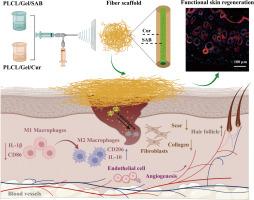综合抗炎抗纤维化双重载药核壳纤维支架:糖尿病伤口愈合和疤痕减少
IF 14.3
1区 材料科学
Q1 MATERIALS SCIENCE, MULTIDISCIPLINARY
引用次数: 0
摘要
疤痕对伤口愈合构成了重大挑战,特别是与糖尿病有关的慢性伤口。本研究通过静电纺丝开发了一种双重药物负载的核-壳纤维支架(PSPC),其外壳含有姜黄素(Cur),核心含有丹酚酸B (SAB),通过协同抗炎和抗纤维化功效来解决这一具有挑战性的问题。PSPC支架具有良好的拉伸性能(抗拉强度为3.67±0.32 MPa,断裂伸长率为337.64%±32.07%)和缝线保持力(2.71±0.17 N),体外实验证实该支架具有生物相容性,支持细胞粘附和增殖。此外,它还清除过多的细胞内活性氧(ROS),促进巨噬细胞向再生M2表型极化。使用小鼠糖尿病伤口模型的体内研究表明,PSPC支架有效减轻炎症反应,促进新血管生成,促进表皮形成和再上皮化。更重要的是,该支架还可以调节胶原合成,降低I/III型胶原的比例,支持毛囊、皮脂腺等皮肤附着物的功能再生,最终达到慢性糖尿病创面愈合和瘢痕减少的目的。所开发的抗炎和抗纤维化双重药物负载纤维支架为慢性伤口的抗疤痕治疗提供了一种很有前景的策略。本文章由计算机程序翻译,如有差异,请以英文原文为准。

Integrated anti-inflammatory and anti-fibrosis dual drug-loaded core-shell fiber scaffolds: Diabetic wound healing and scar reduction
Scarring poses a significant challenge in wound healing, especially for chronic wounds like those linked to diabetes. This study developed a dual drug-loaded core-shell fiber scaffold (PSPC) containing curcumin (Cur) in the shell and salvianolic acid B (SAB) in the core via electrospinning to address this challenging issue through synergistic anti-inflammatory and anti-fibrosis efficacy. The PSPC scaffold presented favorable tensile properties (3.67 ± 0.32 MPa of tensile strength and 337.64% ± 32.07% of elongation at break) and suture retention (2.71 ± 0.17 N). In vitro experiments confirmed that this scaffold was biocompatible, supporting cell adhesion and proliferation. Additionally, it also scavenged excessive intracellular reactive oxygen species (ROS) and promoted macrophage polarization towards the regenerative M2 phenotype. In vivo studies using a mouse diabetic wound model showed that the PSPC scaffold effectively mitigated inflammatory responses, promoted neoangiogenesis, and facilitated epidermal formation and re-epithelialization. More importantly, the scaffold also modulated collagen synthesis, decreased the collagen type I/III ratio, supported the functional regeneration of hair follicles, sebaceous glands, and other skin appendages, then ultimately achieved the goal of chronic diabetic wound healing and scar reduction. The developed dual drug-loaded fiber scaffold integrating anti-inflammatory and anti-fibrosis presents a promising strategy for the anti-scarring treatment of chronic wounds.
求助全文
通过发布文献求助,成功后即可免费获取论文全文。
去求助
来源期刊

Journal of Materials Science & Technology
工程技术-材料科学:综合
CiteScore
20.00
自引率
11.00%
发文量
995
审稿时长
13 days
期刊介绍:
Journal of Materials Science & Technology strives to promote global collaboration in the field of materials science and technology. It primarily publishes original research papers, invited review articles, letters, research notes, and summaries of scientific achievements. The journal covers a wide range of materials science and technology topics, including metallic materials, inorganic nonmetallic materials, and composite materials.
 求助内容:
求助内容: 应助结果提醒方式:
应助结果提醒方式:


